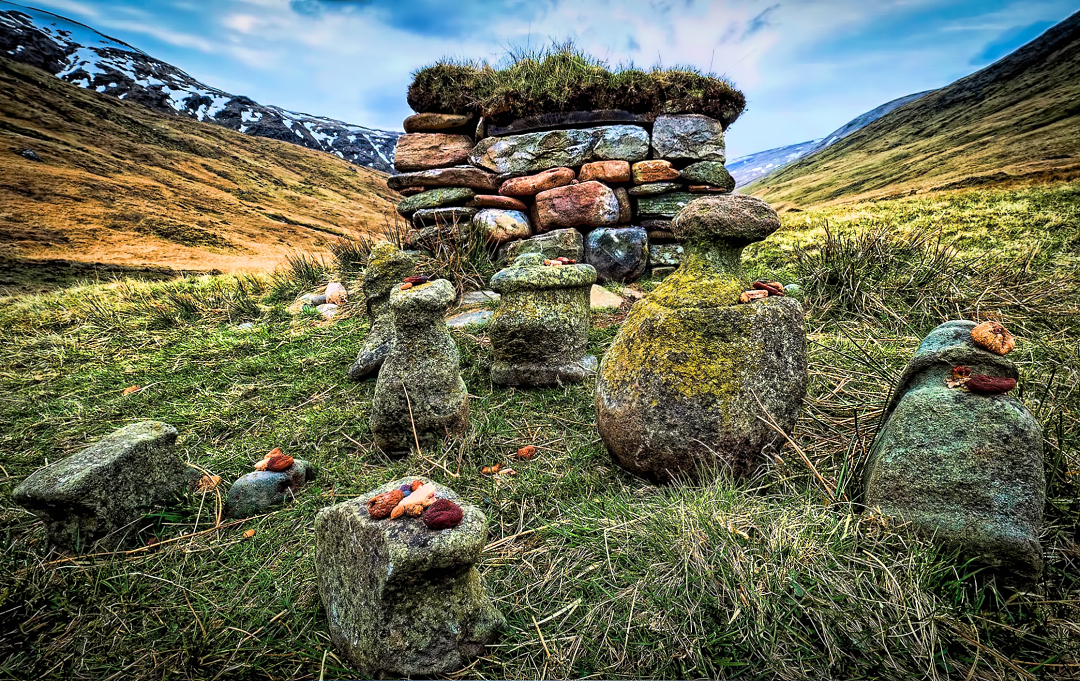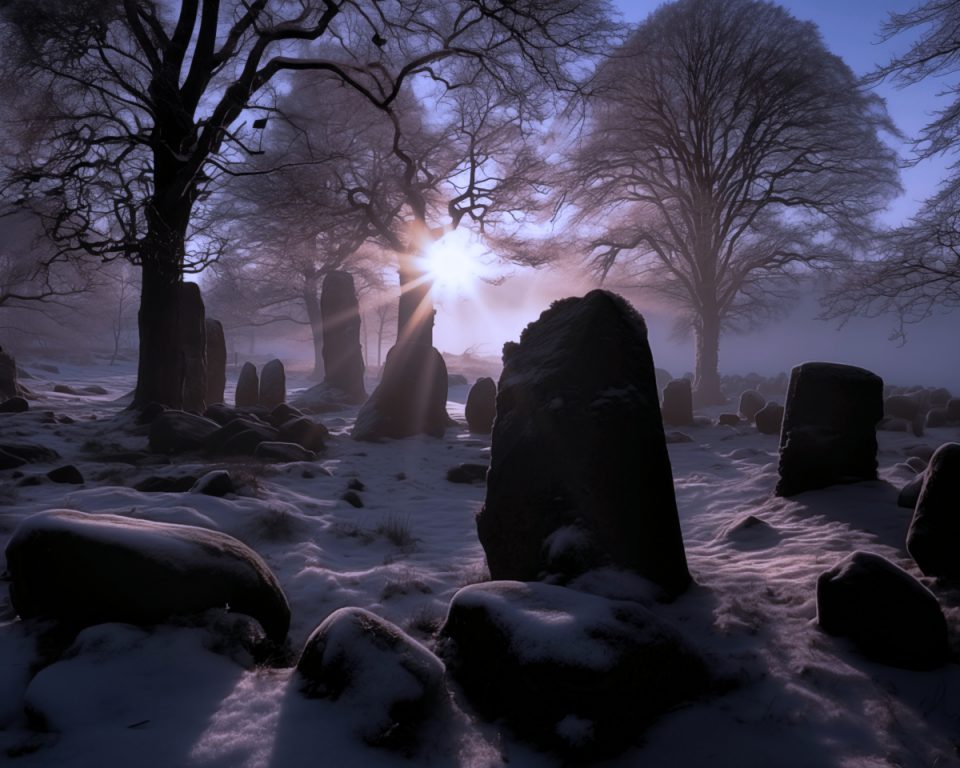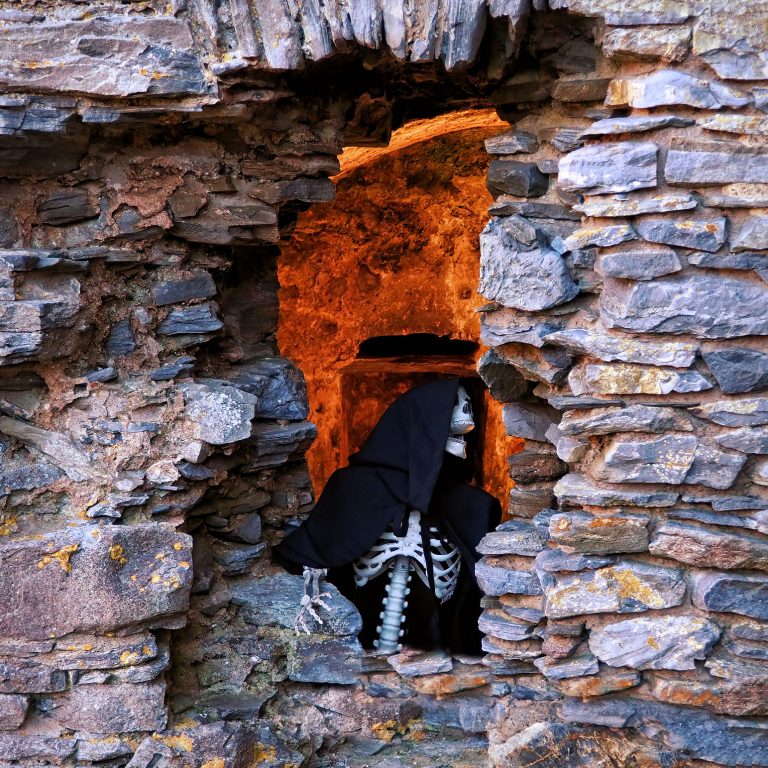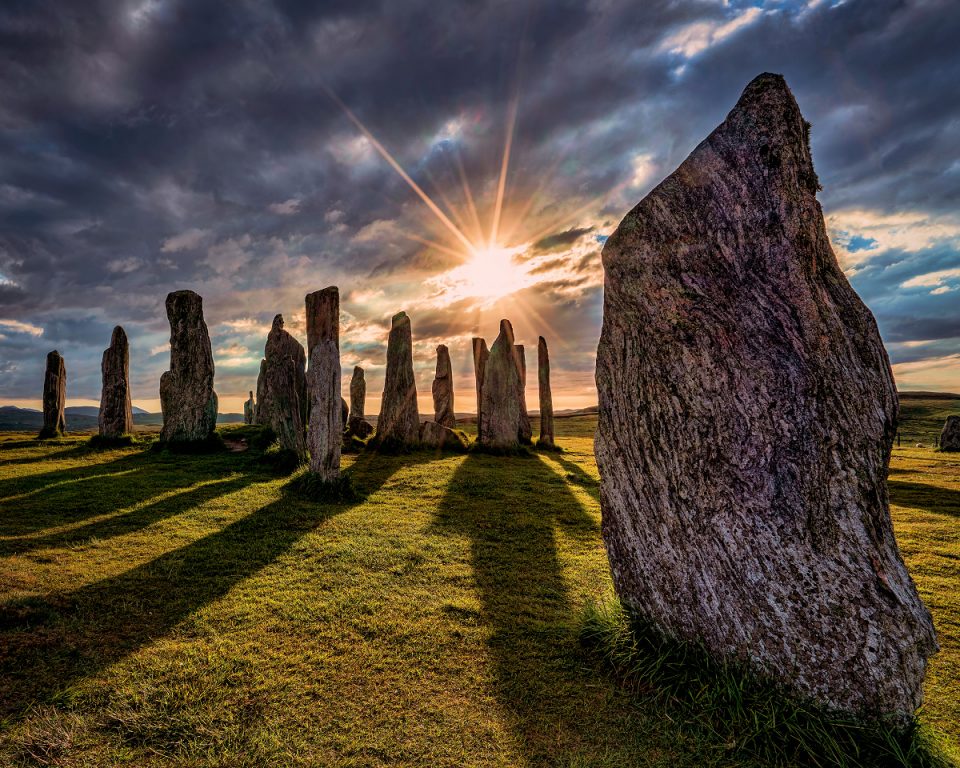The origins of Halloween date back to an ancient Celtic festival known as Samhain (pronounced sow-in) which celebrated the harvest and the arrival of the Cailleach. For the Celts who lived some 2,000 years ago, November 1st was their New Year. It was a time when the early farmers met together, bonfires were lit and animals were sacrificed. Samhain was about the changing seasons and the preparing for the dormancy and rebirth of nature as summer turned to winter and the Cailleach replaced Brìde as Goddess over the long, dark winter months. It was their way of interpreting the turning of the year.
The Celtic Festival of Samhain
The Celts believed that Samhain marked the end of summer and the harvest. It was the beginning of the long cold winter, a time when many humans died. They believed that on the eve before the New Year, the boundary between the worlds of the living and the dead became blurred. This was a time when the ghosts of the dead returned to the Earth. This was seen as a mixed blessing. Malevolent spirits could cause trouble and destroy crops. On the other hand, the presence of otherworldly beings made it easier for the Druids to make predictions about the future.
In time Christianity spread across Europe and the old Gods were replaced. In an attempt to make Christianity more palatable, the early Christian church had a policy of deliberately replacing dates in the old pagan calendar with new Christian Holy Days. The indigenous Celtic people of the British Isles were thus able to keep a foot in both camps. In time the old beliefs turned into the myths which were passed down through the generations to the present time.
So who was the Cailleach and what role does she play?
Who is the Cailleach?
In the folk tales of Scotland and Ireland, there is a figure known as the Cailleach. She is portrayed as a supernatural hag goddess, one of the Mother Goddesses. The Cailleach serves multiple roles and has been given a variety of names including the Queen of Winter and Lady of the Beasts. She may also be known as Cailich, Carlin, the Cailleach Bheara(ch) or Bheur(ach). It was originally thought that the idea of the Cailleach was carried from Ireland by the Gaelic speaking people who emigrated and colonised the west coast of Scotland and build the Kingdom known as Dalriada. However, this has recently been brought into question by folklorists such as Katherine Briggs and Stuart McHardy who have pointed out that more stories exist of the Cailleach in Scotland than in Ireland. The stories about the Cailleach are not found just amongst the Gaelic speakers of the world.
On the east of Scotland, where many people are descended from the Picts and where the Scots language developed in parallel to Gaelic, she is known as Carlin, who is sometimes known as the Queen of Witches. Here she serves the role of being the Corn Maiden or corn dolly. In the North East of Scotland she is known amongst the fisher folk as ‘Gentle Annie’, bringer of the winter storms and gales.
Her name in Gaelic means the hooded or veiled one and after Christianity arrived in Scotland nuns became known as Cailleach dubh. The word cailleach can also be used to refer to an old woman or widow. It is also used in the following words:
cailleach-oidhche: owl (oidhche means night)
cailleach feasa: wise woman or fortune teller
cailleach-phiseogach: a sorceress
In Scots Gaelic the Cailleach in its plural form is cailleachan: the Storm Hags who personify the destructive powers of the natural world.
The Cailleach’s Physical Appearance
In appearance, she was believed to have a dark blue face, dull complexion with teeth as red as rust. She had a single eye on her forehead, which…” was keen and sharp as ice and as swift as the mackerel of the ocean.” Her hair was long and white. Her clothing was grey except for a dun-coloured shawl which she wore tightly wrapped around her shoulders. She is often portrayed as being a giant and in one legend, the waters of the Sound of Mull only came up to her knees.
What Roles does the Cailleach have?
The Cailleach was a goddess who, as a personification of the seasons controlled the weather and the winter between Samhain until Beltane (May 1st). During the winter months, she herded deer, resisted springtime and froze the soil with her staff. She was also considered to be the embodiment of a corn or harvest spirit.
In Scotland, the Cailleach is credited with creating many of the country’s Lochs and Mountains along with eight other hags who are her servants. One of these servants was Nessa, who is said to have created Loch Ness. As the Cailleach strode across the land, stones accidentally slipped from her creel or wicker basket to form some of Scotland’s hills and mountains. In other tales she was said to have built the mountains on purpose, to serve as stepping stones.
As a spirit of winter, and in keeping with her animosity towards mortals, the Cailleach had a reputation for helping deer escape huntsmen. For the early Celts, venison would have been a welcome addition to their fairly limited diet over the winter months.
The Cailleach and the Myths of Scotland
According to legend, the Cailleach was said to have lived on the following mountains: Ben Nevis, Ben Wyvis, Ben Breac, Ben Cruachan, the Paps of Jura and Schiehallion. In Deeside, there is a burn or stream known as Allt-nan-Cailleach on the mountain Lochnagar and its nearby neighbour is a hill known as Caisteal na Caillich. Then there is Beinn na Caillich in Knoydart and a similarly named hill in the Red Cuillins of Skye.
Her role in bringing on winter includes a tale of her riding out from Ben Nevis with eight other hags to hammer the frost into the ground. The return of the Corryvreckan whirlpool between Jura and Scarba each year is attributed to the Cailleach washing her plaid in the water of the sea. Before the washing, it is said that the roar of a coming tempest is heard on the coast for 20 miles, for a period of three days until the cauldron boils or the whirlpool appears. She then lays her plaid over the mountains to dry. Her plaid is now white from being washed and this is used to explain the appearance of snow in the winter.
Legend has it, that the Cailleach was tired from a long day herding deer. On top of Ben Cruachan she fell asleep and a well she was tending, overflowed spilling down the hills and flooding the glens below, forming first a river and then a loch which today is known as Loch Awe.
A Shrine in Glen Lyon
There is a Glen Cailleach which joins Glen Lyon in Perthshire. In the glen runs a stream Alt nan Cailleach. Over the centuries a pagan tradition has been preserved. There is a small Sheiling in the Glen, Tigh nan Cailleach or Tigh nam Bodach, which houses a series of carved stones. Apparently, the stones represent the Cailleach, her husband the Bodach and their children. Traditionally, the local folk would walk up the glen to take the Cailleach and her stone family out of their house on Beltane and at Samhain, they were returned indoors for winter. According to local lore, the Cailleach and her family were once given shelter in the glen by the inhabitants. In gratitude for their help, she left the stones with the promise that as long as they were cared for, she would ensure the glen would continue to be fertile and prosperous.
The Cailleach and Bride
In partnership with the Goddess Bride, the Cailleach is seen as a seasonal deity or spirit. Where Bride was ruler over the summer months, the Cailleach was said to rule unequivocally throughout the winter months. However, as the dreary dark months of winter passed, her subjects would rebel against her harsh rule. As the Cailleach found her power slipping away, she grew enraged and caused storms throughout January and February in a futile attempt to stall the waning of her power and the transition into spring. This stormy period is known as A’Chailleach.
In some interpretations, Brìde and the Chailleach are two faces of the same goddess and that as the spring approaches, the Chailleach drinks from the Well of Youth, whereby she is transformed into the youthful, beautiful Brìde. However, most of the stories in Scotland, consider them to be two separate beings at odds with one another. Here, the Cailleach is turned into stone over the summer months.
Halloween Wishes
Happy Halloween wishes from everyone at Spooky Scotland. Please share your favourite Halloween experiences with us in the comments section or share the link using the icons below.




